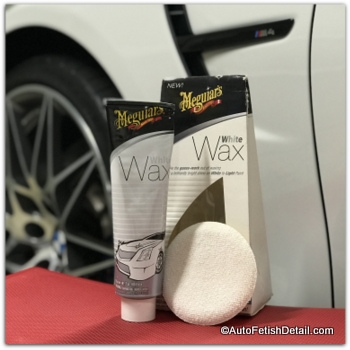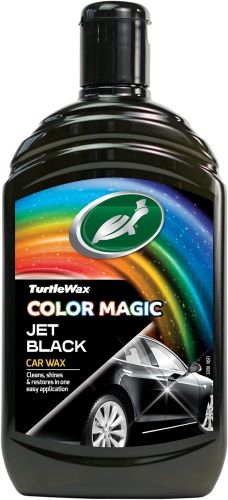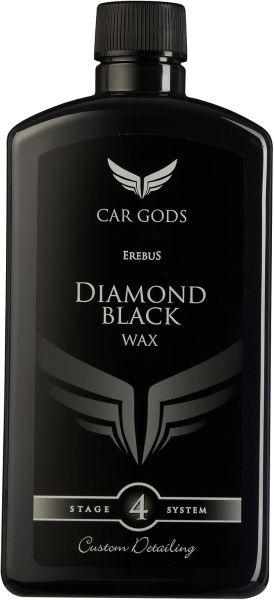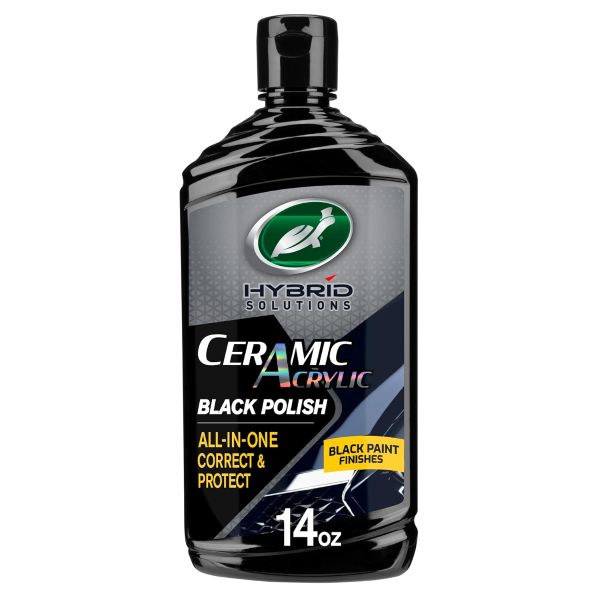Colored Car Wax:
Fact or Fiction
Even though Colored car wax has been around for many years, it is a concept that has not gained as much traction as you might think.
There is sound logic in this concept upon any casual observation: use a colored wax that matches the color of your car to help hide and conceal the imperfections of your car paint.
And based on this logic we have many people go looking
for these tinted car wax products with unrealistic expectations.
Does Tinted or Colored Car Wax Work?

Yes, would be your simple answer to your simple question.
The better question to ask would be this:
"Does colored car wax perform better than a traditional car wax that has no colors or pigments added to it?"
And then we would immediately need to determine what we mean by "better".
I think most people would consider "better" in this context to mean that using a colored car wax the same color as your car will be able to conceal and hide paint imperfections better than a non-colored car wax.
The simple answer to this updated question would also be yes. The less-simple answer would be also be no.
I don't think any person could actually determine the difference when viewing a car that has been waxed with a tinted car wax versus a non-tinted car wax.
Colored Car Wax and the Power of Suggestion
We are emotional creatures prone to being swayed by our emotions and this is where the power of suggestion comes into play.
Colored car wax is a great concept and makes sense.
The suggestion as I have discussed, is that by using a tinted car wax the same color as your car paint, then this will be better.
Let's just accept this and run with this logic.
The problem is that there is only paint color with any dedicated car waxes and this is black paint.
So if you are reading this and you do have a black car and like the idea of using a car wax the same color as your car then you are in luck!
Dedicated Colored Car Wax for Black Paint

Turtle Wax Black Car Wax on Amazon
- Cleans, Shines & Restores: Revives color and clarity while leaving behind a rich, glossy finish.
- Adds Deep Color & Protection: Enhances paint vibrancy and provides long-lasting protection against the elements.
- Easy to Use: Simple, no-fuss application for quick and effective results. Professional-Quality Finish: Delivers a showroom-level shine straight from your driveway.
- New Advanced Formula: Features a dynamic color-boosting technology for deeper tones and improved visual depth.

Car Gods Black Car Wax on Amazon
- 3-in-1 Formula: Restores, enhances, and protects your vehicle’s black paintwork in a single step. Revives Color Depth: Infused with microscopic black pigments that enrich and refresh the appearance of all shades of black paint.
- Long-Lasting Protection: Contains premium carnauba wax to create a hydrophobic barrier that helps keep your paint cleaner for longer.
- Refines and Smooths: Gentle cleaning minerals remove light oxidation, blemishes, and fine scratches — leaving a deep, smooth finish.
- Safe for All Black Finishes: Suitable for use on all types of black paintwork, including metallic, pearlescent, and xirallic finishes.

Turtle Wax Black Polish and Wax on Amazon
- Restores & Protects Black Finishes: Fills in swirl marks, light scratches, and minor imperfections in a single step for a deep, high-gloss black finish.
- Enriched with Black-Pigmented Carnauba Wax: Boosts color depth and shine while enhancing the rich appearance of dark or black paintwork.
- Ceramic-Infused Formula: Creates a durable, hydrophobic layer that repels water and road contaminants, helping your car stay cleaner for longer.
- Easy to Apply: Can be used by hand or with a machine polisher. For maximum durability and longevity, allow 24 hours for the product to cure.
- Perfect Pairing: For added protection and easier maintenance, follow up with Turtle Wax Hybrid Solutions Ceramic Acrylic Black Spray Wax.
- Pleasant Scent: Features the signature Hybrid Solutions tropical-fruit fragrance for a refreshing detailing experience.
Colored Car Wax:
Steps to waxing your car
Regardless of the type of car wax you finally decide upon, there are basic rules to waxing your car you will need to follow:
- Only wax a freshly washed car
- For best results you should decontaminate your car paint first using a clay bar
- Every car wax will inform you as to how often you need to apply wax to your car (my simple rule is that you cannot wax a car too much! The harsher the weather conditions your car must endure, the more frequently you should be waxing your car with "normal" wax or colored car wax. I typically recommend every 3-4 months for the dedicated car owner)
- Use only micro-fiber cloths to remove your car wax (no cloth is softer, safer, or lint free as a micro-fiber cloth)
- You will likely hear endless opinions as to how to apply and remove the car wax based on the pattern of your hand. Many people will tell you never to apply in a circular motion as this will create swirl marks. This simply is not true so apply and remove in any direction you are comfortable with
- Most car waxes regardless of type will be easier to work with on a cool, shaded paint surface.
Colored Car Wax Summary
I will close by saying that life is busy for most of us and this often gets the best of us to want to take short-cuts.
Afterall, you likely don't want to spend all day washing and waxing your car only to hear me tell you that you absolutely, positively should be taking the time and effort to clay your car FIRST before applying wax.
Yes, I know I touched upon this already, but I cannot stress this enough and virtually every other page about car waxes of any type will either ignore this step, or downplay it.
Don't do that!
Washing and waxing is not enough. There are airborne pollutants that will bond to your paint giving it that "textured" feeling, and the only way to deal with this problem is through the separate and dedicated step of claying your car.
Anything doing is worth doing right, and in the context of you and your car and your finished results, I want nothing but satisfaction for you.
This means you gotta' clay your paint first, then you can not only see your amazing results after waxing, but you can feel them!
It is now time to go apply some of my professional tips to bring your car to a new level of beauty and appreciation!
Sincerely,
Darren Priest
- Home
- Car Wax Ratings
- This Page
|
|
